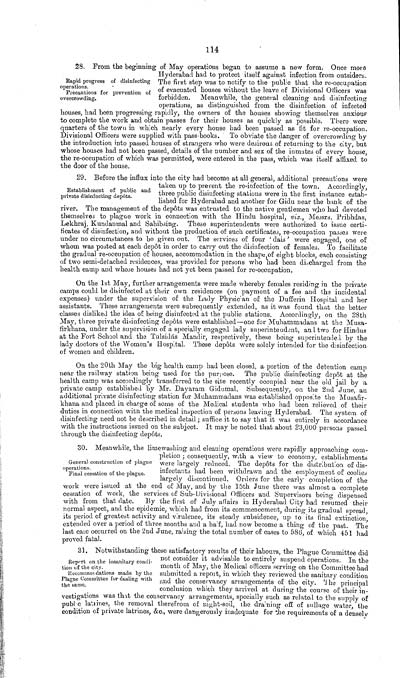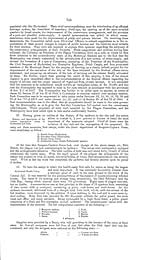Medicine - Disease > Account of plague administration in the Bombay Presidency from September 1896 till May 1897
(126) Page 114
Download files
Individual page:
Thumbnail gallery: Grid view | List view

114
Rapid progress of disinfecting
operations.
Precautions for prevention of
overcrowding.
28. From the beginning of May operations began to assume a new form. Once more
Hyderabad had to protect itself against infection from outsiders.
The first step was to notify to the public that the re-occupation
of evacuated houses without the leave of Divisional Officers was
forbidden. Meanwhile, the general cleaning and disinfecting
operations, as distinguished from the disinfection of infected
houses, had been progressing rapidly, the owners of the houses showing themselves anxious
to complete the work and obtain passes for their houses as quickly as possible. There were
quarters of the town in which nearly every house had been passed as fit for re-occupation.
Divisional Officers were supplied with pass-books. To obviate the danger of overcrowding by
the introduction into passed houses of strangers who were desirous of returning to the city, but
whose houses had not been passed, details of the number and sex of the inmates of every house,
the re-occupation of which was permitted, were entered in the pass, which was itself affixed to
the door of the house.
Establishment of public and
private disinfecting depts.
29. Before the influx into the city had become at all general, additional precautions were
taken up to prevent the re-infection of the town. Accordingly,
three public disinfecting stations were in the first instance estab-
lished for Hyderabad and another for Gidu near the bank of the
river. The management of the depts was entrusted to the native gentlemen who had devoted
themselves to plague work in connection with the Hindu hospital, viz., Messrs. Pribhdas,
Lekhraj, Kundanmal and Sahibsing. These superintendents were authorized to issue certi-
ficates of disinfection, and without the production of such certificates, re-occupation passes were
under no circumstances to be given out. The services of four ' dais' were engaged, one of
whom was posted at each dept in order to carry out the disinfection of females. To facilitate
the gradual re-occupation of houses, accommodation in the shape of eight blocks, each consisting
of two semi-detached residences, was provided for persons who had been discharged from the
health camp and whose houses had not yet been passed for re-occupation.
On the 1st May, further arrangements were made whereby females residing in the private
camps could be disinfected at their own residences (on payment of a fee and the incidental
expenses) under the supervision of the Lady Physician of the Dufferin Hospital and her
assistants. These arrangements were subsequently extended, as it was found that the better
classes disliked the idea of being disinfected at the public stations. Accordingly, on the 28th
May, three private disinfecting depts were established-one for Muhammadans at the Musa-
firkhana, under the supervision of a specially engaged lady superintendant, and two for Hindus
at the Fort School and the Tulsids Mandir, respectively, these being superintended by the
lady doctors of the Women's Hospital. These depts were solely intended for the disinfection
of women and children.
On the 20th May the big health camp had been closed, a portion of the detention camp
near the railway station being used for the purpose. The public disinfecting dept at the
health camp was accordingly transferred to the site recently occupied near the old jail by a
private camp established by Mr. Dayaram Gidumal. Subsequently, on the 2nd June, an
additional private disinfecting station for Muhammadans was established opposite the Musafir-
khana and placed in charge of some of the Medical students who had been relieved of their
duties in connection with the medical inspection of persons leaving Hyderabad. The system of
disinfecting need not be described in detail; suffice it to say that it was entirely in accordance
with the instructions issued on the subject. It may be noted that about 23,000 persons passed
through the disinfecting depts.
General construction of plague
operations.
Final cessation of the plague.
30. Meanwhile, the limewashing and cleaning operations were rapidly approaching com-
pletion; consequently, with a view to economy, establishments
were largely reduced. The depts for the distribution of dis-
infectants had been withdrawn and the employment of coolies
largely discontinued. Orders for the early completion of the
work were issued at the end of May, and by the 15th June there was almost a complete
cessation of work, the services of Sub-Divisional Officers and Supervisors being dispensed
with from that date. By the first of July affairs in Hyderabad City had resumed their
normal aspect, and the epidemic, which had from its commencement, during its gradual spread,
its period of greatest activity and virulence, its steady subsidence, up to its final extinction,
extended over a period of three months and a half, had now become a thing of the past. The
last case occurred on the 2nd June, raising the total number of cases to 586, of which 451 had
proved fatal.
Report on the insauitary condi-
tion of the city.
Recommandations made by the
Plague Committee for dealing with
the same.
31. Notwithstanding these satisfactory results of their labours, the Plague Committee did
not consider it advisable to entirely suspend operations. In the
month of May, the Medical officers serving on the Committee had
submitted a report, in which they reviewed the sanitary condition
and the conservancy arrangements of the city. The principal
conclusion which they arrived at during the course of their in-
vestigations was that the conservancy arrangements, specially such as related to the supply of
publ c latrines, the removal therefrom of night-soil, the draining off of sullage water, the
condition of private latrines, &c., were dangerously inadequate for the requirements of a densely
Rapid progress of disinfecting
operations.
Precautions for prevention of
overcrowding.
28. From the beginning of May operations began to assume a new form. Once more
Hyderabad had to protect itself against infection from outsiders.
The first step was to notify to the public that the re-occupation
of evacuated houses without the leave of Divisional Officers was
forbidden. Meanwhile, the general cleaning and disinfecting
operations, as distinguished from the disinfection of infected
houses, had been progressing rapidly, the owners of the houses showing themselves anxious
to complete the work and obtain passes for their houses as quickly as possible. There were
quarters of the town in which nearly every house had been passed as fit for re-occupation.
Divisional Officers were supplied with pass-books. To obviate the danger of overcrowding by
the introduction into passed houses of strangers who were desirous of returning to the city, but
whose houses had not been passed, details of the number and sex of the inmates of every house,
the re-occupation of which was permitted, were entered in the pass, which was itself affixed to
the door of the house.
Establishment of public and
private disinfecting depts.
29. Before the influx into the city had become at all general, additional precautions were
taken up to prevent the re-infection of the town. Accordingly,
three public disinfecting stations were in the first instance estab-
lished for Hyderabad and another for Gidu near the bank of the
river. The management of the depts was entrusted to the native gentlemen who had devoted
themselves to plague work in connection with the Hindu hospital, viz., Messrs. Pribhdas,
Lekhraj, Kundanmal and Sahibsing. These superintendents were authorized to issue certi-
ficates of disinfection, and without the production of such certificates, re-occupation passes were
under no circumstances to be given out. The services of four ' dais' were engaged, one of
whom was posted at each dept in order to carry out the disinfection of females. To facilitate
the gradual re-occupation of houses, accommodation in the shape of eight blocks, each consisting
of two semi-detached residences, was provided for persons who had been discharged from the
health camp and whose houses had not yet been passed for re-occupation.
On the 1st May, further arrangements were made whereby females residing in the private
camps could be disinfected at their own residences (on payment of a fee and the incidental
expenses) under the supervision of the Lady Physician of the Dufferin Hospital and her
assistants. These arrangements were subsequently extended, as it was found that the better
classes disliked the idea of being disinfected at the public stations. Accordingly, on the 28th
May, three private disinfecting depts were established-one for Muhammadans at the Musa-
firkhana, under the supervision of a specially engaged lady superintendant, and two for Hindus
at the Fort School and the Tulsids Mandir, respectively, these being superintended by the
lady doctors of the Women's Hospital. These depts were solely intended for the disinfection
of women and children.
On the 20th May the big health camp had been closed, a portion of the detention camp
near the railway station being used for the purpose. The public disinfecting dept at the
health camp was accordingly transferred to the site recently occupied near the old jail by a
private camp established by Mr. Dayaram Gidumal. Subsequently, on the 2nd June, an
additional private disinfecting station for Muhammadans was established opposite the Musafir-
khana and placed in charge of some of the Medical students who had been relieved of their
duties in connection with the medical inspection of persons leaving Hyderabad. The system of
disinfecting need not be described in detail; suffice it to say that it was entirely in accordance
with the instructions issued on the subject. It may be noted that about 23,000 persons passed
through the disinfecting depts.
General construction of plague
operations.
Final cessation of the plague.
30. Meanwhile, the limewashing and cleaning operations were rapidly approaching com-
pletion; consequently, with a view to economy, establishments
were largely reduced. The depts for the distribution of dis-
infectants had been withdrawn and the employment of coolies
largely discontinued. Orders for the early completion of the
work were issued at the end of May, and by the 15th June there was almost a complete
cessation of work, the services of Sub-Divisional Officers and Supervisors being dispensed
with from that date. By the first of July affairs in Hyderabad City had resumed their
normal aspect, and the epidemic, which had from its commencement, during its gradual spread,
its period of greatest activity and virulence, its steady subsidence, up to its final extinction,
extended over a period of three months and a half, had now become a thing of the past. The
last case occurred on the 2nd June, raising the total number of cases to 586, of which 451 had
proved fatal.
Report on the insauitary condi-
tion of the city.
Recommandations made by the
Plague Committee for dealing with
the same.
31. Notwithstanding these satisfactory results of their labours, the Plague Committee did
not consider it advisable to entirely suspend operations. In the
month of May, the Medical officers serving on the Committee had
submitted a report, in which they reviewed the sanitary condition
and the conservancy arrangements of the city. The principal
conclusion which they arrived at during the course of their in-
vestigations was that the conservancy arrangements, specially such as related to the supply of
publ c latrines, the removal therefrom of night-soil, the draining off of sullage water, the
condition of private latrines, &c., were dangerously inadequate for the requirements of a densely
Set display mode to: Large image | Zoom image | Transcription
Images and transcriptions on this page, including medium image downloads, may be used under the Creative Commons Attribution 4.0 International Licence unless otherwise stated. ![]()
| India Papers > Medicine - Disease > Account of plague administration in the Bombay Presidency from September 1896 till May 1897 > (126) Page 114 |
|---|
| Permanent URL | https://digital.nls.uk/74517262 |
|---|




